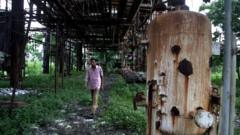Residents of Pithampur, Madhya Pradesh, protest the disposal of toxic waste linked to the 1984 Bhopal gas tragedy, fearing long-term health risks and environmental damage.
Toxic Waste from Bhopal Gas Tragedy Triggers Fierce Protests in Madhya Pradesh

Toxic Waste from Bhopal Gas Tragedy Triggers Fierce Protests in Madhya Pradesh
Residents express fears of environmental disaster as hazardous waste disposal begins.
Protests have erupted in Pithampur, a town in Madhya Pradesh, following the arrival of 337 tonnes of toxic waste from the infamous 1984 Bhopal gas tragedy, which remains one of the deadliest industrial disasters in history. The waste, held in a dozen containers by the now-closed Union Carbide factory, has ignited public outcry among locals who are concerned about potential health hazards and environmental risks linked to its disposal.
Shivnarayan Dasana, a local vegetable vendor, witnessed an unprecedented police presence in Tarapur, a village within Pithampur, where heavy police patrols have now maintained order since protests ignited on January 3rd, the day after the waste's arrival. With tensions running high, protests have escalated, leading to stone-throwing incidents and attempted self-immolations, prompting authorities to file cases against dozens of demonstrators.
The controversial waste includes pesticide residues and “forever chemicals” that have long-lasting toxic properties and have contaminated surrounding areas for decades. Local residents are wary of the disposal location due to past experiences with industrial pollution, raising alarms about the threat to their land and drinking water.
Officials have sought to reassure the community, with Swatantra Kumar Singh, a senior government official, detailing a thorough incineration process designed to destroy hazardous materials at 1,200°C (2,192°F) and ensure that emissions are filtered. Madhya Pradesh Chief Minister Mohan Yadav has publicly defended the operation, citing court approval as part of the justification.
However, environmental experts diverge in their views. While some support the incineration process if conducted correctly, others, such as Shyamala Mani, advocate for alternatives like bioremediation, arguing that incineration may pose further risks through the release of harmful toxins.
Community sentiment remains starkly opposed; Gayatri Tiwari, a local mother, encapsulates the widespread fears concerning health and safety, stating emphatically, “It's not just waste. It's poison.” The residents point to troubling health outcomes linked to previous industrial pollution in the area, including water contamination and alarming rates of skin diseases and kidney issues.
Despite government assurances, skepticism pervades as local activists criticize the disposal as a mere act of deflection from more significant, unresolved contamination issues still plaguing Bhopal itself, including an estimated 1.1 million tonnes of contaminated soil at the Union Carbide site.
As tensions rise in Pithampur, community leaders suggest that the fight against hazardous waste disposal is not just about the toxic materials being handled—it’s a struggle for survival and health for the current and future generations. Residents, buoyed by their long-standing experiences with industrial pollution, remain prepared to mobilize for their rights and safety.





















